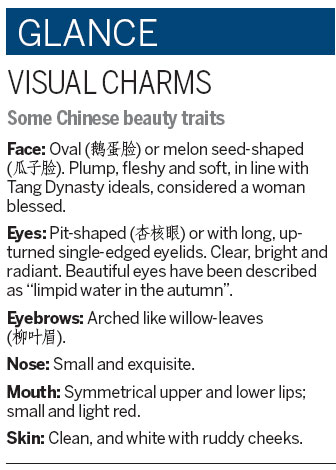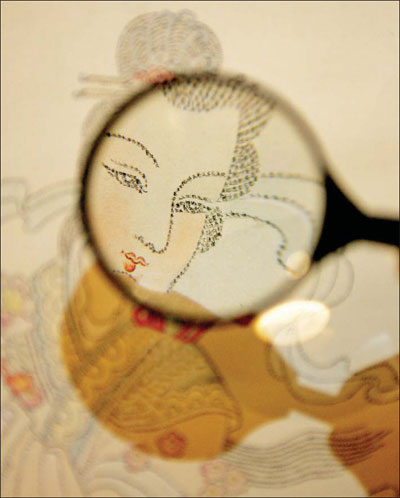Looks that cast a spell
Updated: 2012-06-29 07:39
By Yin Yin (China Daily)
|
||||||||
|
A wide forehead, round face and portly figure were regarded as characteristics of beauty in the Tang Dynasty (AD 618-907). A Jing / For China Daily |
Concept of beauty always changes, but some old ideas about feminine allure remain
For Natasha Richard, the models Emma Pei, Liu Wen and Du Juan are the epitome of Chinese feminine beauty.
"They are natural, fresh and have elongated eyes," the US designer says. "Theirs is the face I see on ancient Chinese paintings, they represent a typical 'Oriental belle'.
"Most importantly, these supermodels are not going under the knife these days, and they always exude an air of confidence."
Richard also knows that the traditional Chinese notion of beauty was far from what Chinese girls aspire to be nowadays.
Throughout Chinese history, people have had distinct ideas about beautiful women. In general, they were small-boned with fair skin, boasted oval faces, bright eyes, willow-leaf-shaped eyebrows and mouths that curved upward at the corners.
Understandably, these standards fluctuated in different times to reflect changing cultural norms and customs.
Before the Qin Dynasty (221-206 BC), "effeminate and delicate" were the standards people used to judge a beautiful woman.
From the Han Dynasty (206 BC-AD 220) to the Southern and Northern Dynasties (AD 420-581), they stressed morality over physical beauty.
During this time, women's clothes and accessories were very simple but they did allow their faces to be powdered with a special rice-based foundation.
During the Sui Dynasty (AD 581-618) and the Tang Dynasty (AD 618-907), natural, plump, graceful and healthy became bywords for beauty.
Yang Yuhuan, an imperial concubine of Emperor Xuanzong of the Tang Dynasty, was held up as one of China's four beauties. Yang was plump, with a round, reddish-white face and cherry mouth and arched brows to match.
"We can get this from many Tang paintings ... a wide forehead, round face and portly figure were supposed to be the indispensable characteristics of beauty. In particular, a look of healthiness was also a trait admired by people at that time," says Hu Lan, an expert in Chinese classical physiognomy with more than three decades of experience.
The idea of Chinese beauty changed from the time of the Song Dynasty (960-1279): thin shoulders, a slender waist, flat chest and bound feet with a pale face that seemed to be in need of care and protection became valued.
But these traits became a victim of trends themselves in the 1930s - by then, as China moved into modern times, the overly delicate look became regarded as being too "bland".
The Shanghai actress Hu Die was considered to fit the bill when it came to the popular concept of beauty. She had chubby cheeks, arch eyebrows, a little dimple, an ample bosom and full hips - all suggestive of the changing perceptions of the times.
Chinese concepts of beauty were also inevitably connected to physiognomy, the study of one's face, and the fortunes attached to it.
"In traditional Chinese physiognomy, a woman with a high and full forehead is auspicious and indicates good luck and prosperity. A lady with a forehead that looked like a half-moon, with a clear hairline, is known as a lucky woman," Hu says.
Apricot seed-shaped eyes, round, extended and shining with a pleasant radiance, help indicate that a woman is lucky.
"The lying silkworm, or wocan (卧蚕), was also used to describe vivid eyes as a woman 'smiled' through her lower eyelid," Hu says.
Hu says that when a face is round, fleshy and soft, the owner is considered fortunate and can bring her husband good luck.
If a woman has high and thin cheekbones, with pointed chin, it denotes an unlucky person who is secretive and may face troubles in life, or bring harm to her husband.
"A straight nose of normal length makes a lady beautiful, wise, and witty. If the nose bridge seems plump, it is fortuitous for her husband.
"When the upper lip is soft and convex in the center, it shows luck and passion. Similarly, if the lower lip is round and red, the woman is very wealthy. A thin, long, fuscous mouth is a sign of ill-luck. Drooping lips are also deemed 'poor'," Hu says.
The pursuit of the perfect look, however changing, has driven many Chinese women to go under the knife, with resorting to cosmetic surgery.
Many say Chinese women are also opting to look more like their Western counterparts, many of whom undergo breast enhancement and liposuction. Still, choices differ according to culture.
"The most universal plastic surgeries are double eyelid reconstruction, face-lift and rhinoplasty," says Li Bin, a plastic surgeon at the Chinese Academy of Medical Sciences.
"Many girls have single and narrow eyelids, but double eyelid procedures can make their eyes larger. But this is not suitable for everyone."
More Chinese women now also aspire to sport more pointed chins, achieved through bone surgery and which can involve high risk.
"You can see the move toward the West; micro-plastic surgery is also getting popular among Chinese women. For example, botulinus toxin injections are widely used to remove double chins and chubby cheeks; whitening injections are also carried out based belief that a lighter skin is more desirable than a darker one," Li says.
"The idea of the real and natural Chinese look continues to change over time ... and people will continue to have different views of what beauty is."
yinyin@chinadaily.com.cn

(China Daily 06/29/2012 page18)

 Relief reaches isolated village
Relief reaches isolated village
 Rainfall poses new threats to quake-hit region
Rainfall poses new threats to quake-hit region
 Funerals begin for Boston bombing victims
Funerals begin for Boston bombing victims
 Quake takeaway from China's Air Force
Quake takeaway from China's Air Force
 Obama celebrates young inventors at science fair
Obama celebrates young inventors at science fair
 Earth Day marked around the world
Earth Day marked around the world
 Volunteer team helping students find sense of normalcy
Volunteer team helping students find sense of normalcy
 Ethnic groups quick to join rescue efforts
Ethnic groups quick to join rescue efforts
Most Viewed
Editor's Picks

|

|

|

|

|

|
Today's Top News
Chinese fleet drives out Japan's boats from Diaoyu
Health new priority for quake zone
Inspired by Guan, more Chinese pick up golf
Russia criticizes US reports on human rights
China, ROK criticize visits to shrine
Sino-US shared interests emphasized
China 'aims to share its dream with world'
Chinese president appoints 5 new ambassadors
US Weekly

|

|








